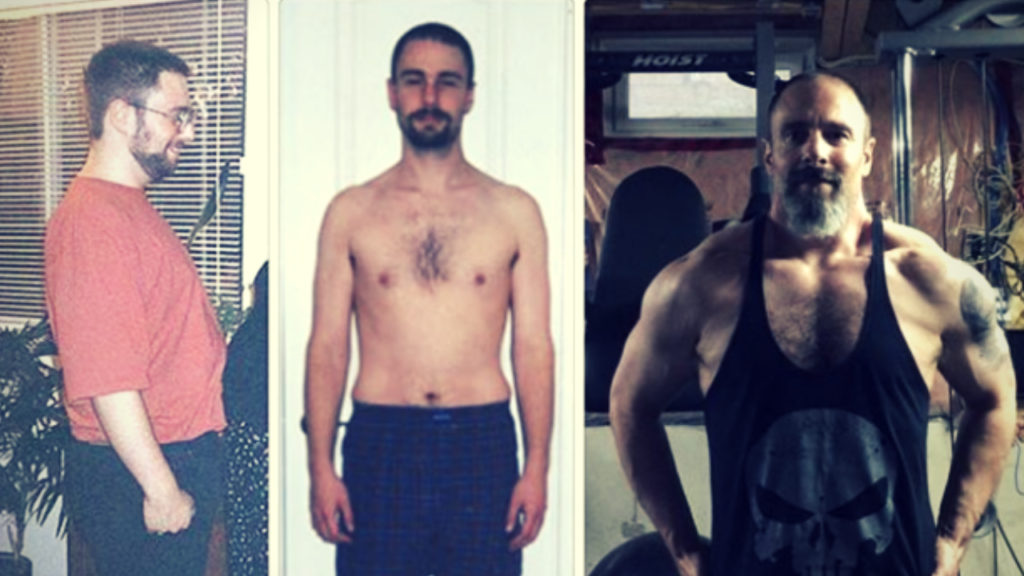Recovery.
Recovery can mean so many things. For gym rats, it’s what we do after a workout. A time when the damage we did with the weights, heals muscles adapting to this latest stress we’ve put to them, so that next time … next time they will be ready. They get stronger. They get more efficient. The heart is a muscle. And, philosophically speaking, so is the mind.
Growing up, I was a skinny kid. When I hit puberty, I started to gain fat slowly, but steadily. As an adult, I floated on a wave of gaining and losing, reaching a peak of 250 lbs. In my 30’s I started lifting weights regularly, eventually setting up my own gym in the basement of my house. I also began paying much more attention to nutrition, but as a confirmed food addict, I always struggled with proper diet. Then, in 2014, I had a heart attack.
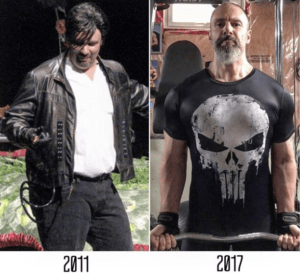 45 and Almost Dead
45 and Almost Dead
That’s right. At the age of 45, I had a heart attack. In the photo from 2011, I weighed about 250 lbs. I don’t want you to be misled in any way. I was not at that weight when it happened. Thanks to a good run of discipline in the kitchen and gym, I weighed about 225 lbs., much of which was muscle, but certainly on the fat side. You can read about the heart attack itself (and many other topics, for that matter) on my website. I won’t go into details here except to say it was damn scary. I naturally assumed it was due to my weight and, or my eating habits. In fact, the cardiologist told me that it was neither – just genetics. Since I don’t drink or smoke, and since I was not really in bad shape physically, he told me I had “no correctable risk factors”. That was scary to hear. But he also told me that now that we knew that I am prone to this, and now that I was the proud owner of 3 brand new stents, we can control it with medication. He assured me that I can lead a normal, healthy life.
Normal. Healthy.
Those are two heavy words. The first one offends me a little. Who wants to be normal anyway? But the second one means so much. That heart attack was scary. I remember a friend of mine is a doctor who does rounds at the hospital where I was staying, stopped in to chat the next day. He told me guys my age that have a heart attack can go on to lead healthy lives, seemingly unaffected. I remember asking him about weightlifting, which I had already sacrificed in my mind. How could anyone who had a heart attack keep on lifting heavy weights? Prior to my heart attack I had been putting up some big numbers. I deadlifted 405 lbs. for 4 reps, benched a 315 lb. single, benched 225 lbs. for 20 reps, and I managed 20 pull-ups in one set. I had goals – a 495 lb. deadlift, 315 lb. bench for 4, 225 lb. bench for 30, and 40 pull-ups. The heart attack made me say goodbye to all of them, both because I didn’t see how I could do that anymore, and because I wasn’t sure I should even try. My friend said of course I could still lift. I said I lift really heavy weight. He said, so what?
Wow. You mean I can still lift? It was hard to believe. My cardiologist said sure, when you’ve recovered from the heart attack and the angioplasty, why not? He also said I need to make sure to do cardio to exercise my heart and help it recover from the damage.
Four Elements of My Recovery
See? There’s that word: Recovery. My heart was damaged. So, I had to set out to make it stronger. I had to make it more efficient. Recover is what I set out to do. I consider as a way of being: It’s not a destination, it’s a journey. I break it into four distinct but very related categories: Cardio, Weights, Diet and Therapy.
Cardio
As soon as I got the go-ahead from the doc to start pushing my heart rate, I did. The doc said I should make sure to do cardio so that my heart rate was elevated to roughly 80% of max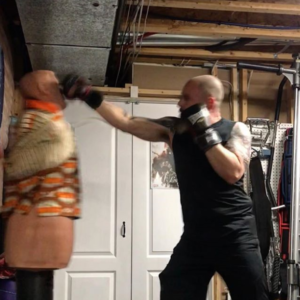 for 45 minutes, 5 times a week. It has been about three years since I got that instruction, and in that time, I have honestly missed about 5-6 sessions, in total. At one point my streak was over 104 weeks straight. 45 minutes on my elliptical, plus a 4-minute cooldown. I try to keep my heart rate in the 140’s for as much of the session as possible, though some days it doesn’t want to go there, whereas others, I feel like I have the wind at my back and it gets up into the 150’s or even short spans in the low 160’s. I’ve asked my doctor if those higher numbers are safe, and he said if it doesn’t hurt, and if I can speak in full sentences, then I am fine. Guidelines are just guidelines. I had a Diamondback elliptical that I used to use from time-to-time before the heart attack, but it broke soon after with the regular use. I wanted to replace it with something sturdier, and I never buy exercise equipment new unless I absolutely must. During the time it took me to find a replacement I would get temporary free introductory passes to local gyms, and when those ran out I actually did cardio in my leg press, with one 45 lb. plate on each side, doing reps for 45 minutes, resting only when I had to and only for as long as it took for me to get my legs going again. Eventually I found a great deal on a used Octane elliptical. It’s a tank! Takes a pounding from me 5 days a week and never complains. It wasn’t cheap – but it was worth it. I also sprang for a TV which I mounted on a shelf right at eye level. The TV, coupled with an Apple TV, serves as the entertainment hub for my basement gym. Netflix gets me through my cardio!
for 45 minutes, 5 times a week. It has been about three years since I got that instruction, and in that time, I have honestly missed about 5-6 sessions, in total. At one point my streak was over 104 weeks straight. 45 minutes on my elliptical, plus a 4-minute cooldown. I try to keep my heart rate in the 140’s for as much of the session as possible, though some days it doesn’t want to go there, whereas others, I feel like I have the wind at my back and it gets up into the 150’s or even short spans in the low 160’s. I’ve asked my doctor if those higher numbers are safe, and he said if it doesn’t hurt, and if I can speak in full sentences, then I am fine. Guidelines are just guidelines. I had a Diamondback elliptical that I used to use from time-to-time before the heart attack, but it broke soon after with the regular use. I wanted to replace it with something sturdier, and I never buy exercise equipment new unless I absolutely must. During the time it took me to find a replacement I would get temporary free introductory passes to local gyms, and when those ran out I actually did cardio in my leg press, with one 45 lb. plate on each side, doing reps for 45 minutes, resting only when I had to and only for as long as it took for me to get my legs going again. Eventually I found a great deal on a used Octane elliptical. It’s a tank! Takes a pounding from me 5 days a week and never complains. It wasn’t cheap – but it was worth it. I also sprang for a TV which I mounted on a shelf right at eye level. The TV, coupled with an Apple TV, serves as the entertainment hub for my basement gym. Netflix gets me through my cardio!
Weights
I also started lifting as soon as I got the go-ahead. At first, I was scared. I went back to square one – benching and squatting the bar only, curling the 10’s … I wasn’t trying to get big or strong, just trying to reacclimate my body – and honestly my mind – to the iron. I imagined it would take months to feel like my old self again under a bar. I was super-cautious, recording my blood pressure before and after sets, making sure it didn’t spike too much. It was not an over-reaction. I believe to this day that all that caution and trepidation was necessary. I had to re-learn the art of listening to my body. All of it. The joints, the muscles, and of course, my heart, (right, I know – that’s a muscle too – but let’s admit it’s a special one worthy of listing separately, okay?) all needed my attention.
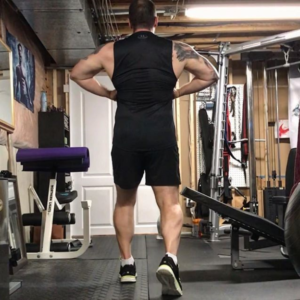 Adjusting Priorities
Adjusting Priorities
I made quick progress, although it took me a long time to start to believe that my old numbers might make themselves known again. My deadlift is probably not going to make a reappearance, but not because of my heart. I have accumulated too many back injuries over the years, due in part to undiagnosed scoliosis and in part to the ego of my inexperience early on. When I deadlift now, I keep it to 225 lbs., tops. But my bench is getting strong again. I can bench 275 lbs. for a single, and at my last chest workout, I managed 225 lbs. for 15 reps. I have managed 20 pull-ups in one set again. My goal now is 50 for my fiftieth birthday. When I train I keep the intensity high for each rep. I think of every rep as a complete workout, every set an accumulation of victories, and every workout a war, won in the battlefield of my little basement gym. I don’t plan to compete in any contests ever again – the taste for that is just not there. And I don’t have any goals but to make myself better each workout. I don’t compare myself to others, but I love to see other gym warriors at all levels. The ones who have pushed farther – who might be viewed as somehow “better” if I were using a different lens – don’t make me get down on myself. They inspire me about what is possible.
Diet
Diet is actually a dumb word, thanks to the fact that it is most commonly used as a verb, or like a proper noun. I am dieting. I am on a Diet. I don’t blame anyone for that, but it does make me reticent to use the word to express the concept. To me, diet refers to the nutrition you consume. As in, my diet is comprised mostly of whole foods. Which is true. But there’s more to it.
Before my heart attack, food was always an issue for me. I was always – I mean always – fighting the urge to eat more, or eat the wrong thing. I am a food addict. Eating was always a negotiation for me. Even before I really knew about proper nutrition, I still knew you’re not supposed to eat four Wunderbars back-to-back. So, whenever I did, it was always a negotiation. And as any chronic overeater will tell you, you always negotiate a future consideration. As in well, I can eat this ice cream now, and then tomorrow I will go for a walk and only eat salad. It is also true that for many, tomorrow never comes. But mine did. Wrapped up as a heart attack.
Ever since the heart attack there has been no negotiation. I do not want to add any risk to whatever I already have, thanks to genetics. I have simple rules:
My Rules for Living
- Choose whole foods whenever possible
- minimize cholesterol and fat (steer as far away from saturated fat as possible)
- make sure to eat enough protein to support muscle growth, and never overeat.
I don’t measure anything, although from years of having done so I admittedly have a sense for what the food scale would say. Truth is though, the never overeat rule takes care of the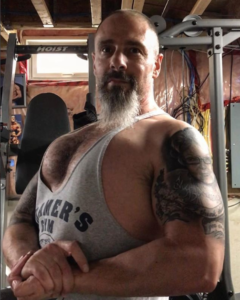 measuring. My body tells me what it needs, and how much – I just have to listen.
measuring. My body tells me what it needs, and how much – I just have to listen.
After my heart attack and once I started exercising, I would weigh myself regularly, and often. I went from 225 lbs. to 185 lbs. But I found I cared less and less about what the scale was telling me. Listening to my body is much more meaningful than reading the scale. Slowly, my frequency of checking the scale went down. Not as a conscious plan, but because I just didn’t think to do it. Now, for fun, I check once every 3-4 months. I did gain weight from the 185 lbs., due to the time in the gym, but I am still wearing the same size pants. For those that are interested, I currently weigh 200 lbs., and have been at this weight for almost 2 years. Truthfully, I don’t care. I feel great. My clothes feel great. My kids and my wife love me, and I love them.
Therapy
Anyone who has gone through something like a heart attack will tell you how it changes your perspective on mortality. For me, it has certainly brought anxiety. Any twinge I feel in my chest makes me wonder. And the wondering makes me anxious. And the anxiety makes my chest hurt. The circle is as terrible as it is obvious. I needed a way to calm the anxiety, and surprisingly the gym doesn’t do it. Probably because if I were having another heart attack, working out would exacerbate the pain, so my brain doesn’t allow that to be the outlet it is for so many other types of stress. I found I needed an activity to get lost in. About two years ago I set out to learn to draw. My goal was to leverage my passion for bodybuilding and draw muscled up characters. At first, I sucked at it. But when I was drawing I realized the phantom chest pain disappeared entirely. And the more I drew, the more it stayed away. In other words, I could control the anxiety by drawing! So I drew, and drew, and drew some more. I am very fortunate that my career as a high school teacher allows me to have the summer months off. That first summer, I probably spent 8-10 hours a day, seven days a week; drawing. I made progress and the progress spurred me on, just like in the gym.
Most weeks I draw at least three days. Some weeks every day. I can draw for 30 minutes or 5 hours. It all depends on how my day is shaping up and how I feel. Of course, the anxiety still surfaces sometimes. It always will. But I know that when I draw, it leaves, and that gets me through it with a smile.
Want to read more from Rich? Or keep up with his progress?
Follow him on Instagram @richdhomegym
See more of Rich’s art @studiodlin on Instagram.
Commission Rich to do a piece by contacting him at https://www.studiodlin.com/

